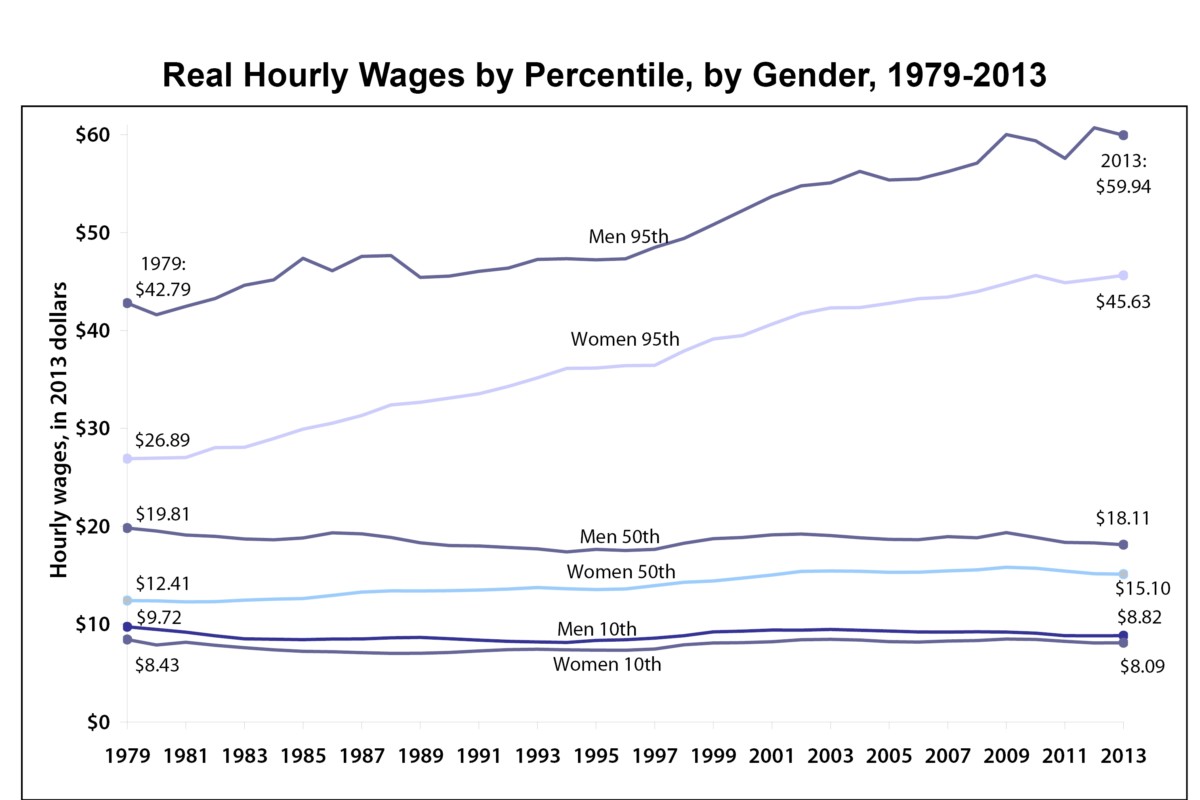Last year the median (or typical) woman worker made $15.10 an hour, while the median man made $18.11.
The persistent gender wage gap affects earners at all levels, high to low, from the boardroom on down. What’s to be done?
Evolving Gap
Though still large, the wage gap is smaller than it used to be. It began to narrow in the late 1970s, partly for good reasons. Thanks to the women’s movement and women’s organizing and agitation for equality, women were getting more education and more work experience, and moving into higher-paid occupations.
But for the entire bottom 60 percent of wage earners, there was a troubling dynamic—a big part of the closing of the gap occurred because men’s wages were falling.
This is clearly not the kind of improvement in the wage gap that actually helps women. In fact, lately wages for many women have been falling, too (see box).
At this point, what’s depressing most women’s wages is less the gap from men—and more the gap from the top 10%.
The dramatic rise in inequality that has kept wages down for most workers, women and men, for a generation does not have to continue. It has been driven by government policies that favor the already affluent, and these can be changed.
What Can We Do?
Here are eight priorities for working women in 2014:
1. Restore and Bolster Public Services. In the short run, the urgent issue affecting women’s wages and job quality is high unemployment. It’s obviously a disaster for job seekers, but it also holds down wage growth for people with jobs, since employers don’t have to pay much to keep the workers they need when those workers lack options.
We need 7.6 million jobs to get back to pre-recession health of the labor market: 3.6 million for women and 4 million for men.
Businesses aren’t hiring because they have not seen demand for their goods and services pick up, so the most direct way to create jobs is to boost demand. A good start would be to reverse the savage austerity this country has undertaken, by reestablishing the public services and public sector jobs that were cut in the Great Recession.
But of course, for three decades leading up to the Great Recession, rising inequality was already blocking wage growth for low- and middle-wage workers. To reverse that trend, we should:
2. Increase the Minimum Wage. Its real value has eroded dramatically and is now more than 25 percent below its peak in the late 1960s. The Fair Minimum Wage Act would raise the minimum to $10.10 by 2016. Around 55 percent of those who would see a raise are women.
Further, the bill would raise the minimum for workers who earn tips—which has been frozen at $2.13 per hour for more than 20 years—to 70 percent of the minimum wage. Around 75 percent of tipped workers are women.
3. Unionize, and Defend the Unions We Have. The decline in unionization is one reason for the growing wage gap between low-wage and high-wage women. We need to update labor law to keep pace with increased employer aggressiveness in fighting unions, and shore up enforcement of existing law.
4. Enact Mandatory Paid Leave. A place to start would be paid sick leave for the almost 40 percent of private sector workers who lack the right to even a single paid sick day. (See here to read how a local coalition boosted paid sick day rights and the minimum wage in the D.C. area.)
5. Update Overtime Laws. The Fair Labor Standards Act is still using an old cut-off point beyond which employers don’t have to pay time-and-a-half for overtime. It allows workers making $455 per week or more—or $11.38 an hour for a 40-hour week—to be counted as salaried so they are exempt.
6. Win Immigration Reform with a Path to Citizenship. A large pool of easily exploitable workers with little bargaining power hurts not just their wages but also the wages of immigrant or native-born workers who do similar work.
7. Stop the Trans-Pacific Partnership. Our current trade agreements (and the new ones in the wings) reliably protect corporations while promoting a race to the bottom on labor standards. We need to make the rules governing globalization fairer to workers.
8. Tax the Rich. The income hikes for the top 1 percent—primarily corporate executives and financial professionals—have been far over and above what was needed to induce those people to do their work. This concentration of earnings at the top has been a key impediment to wage increases for the rest of us.
One obvious remedy is to significantly hike the marginal tax rates on high incomes, as California did in 2012.
Before Midnight: Last Chance to Have Your Gift Matched!
Before midnight tonight, all donations to Truthout will be matched dollar for dollar up to $11,000! Thanks to a generous supporter, your one-time gift today will be matched immediately. As well, your monthly donation will be matched for the whole first year, doubling your impact.
We have just a few hours left to raise $11,000 and receive the full match.
This matching gift comes at a critical time. As Trump attempts to silence dissenting voices and oppositional nonprofits, reader support is our best defense against the right-wing agenda.
Help Truthout confront Trump’s fascism in 2026, and have your donation matched now!
